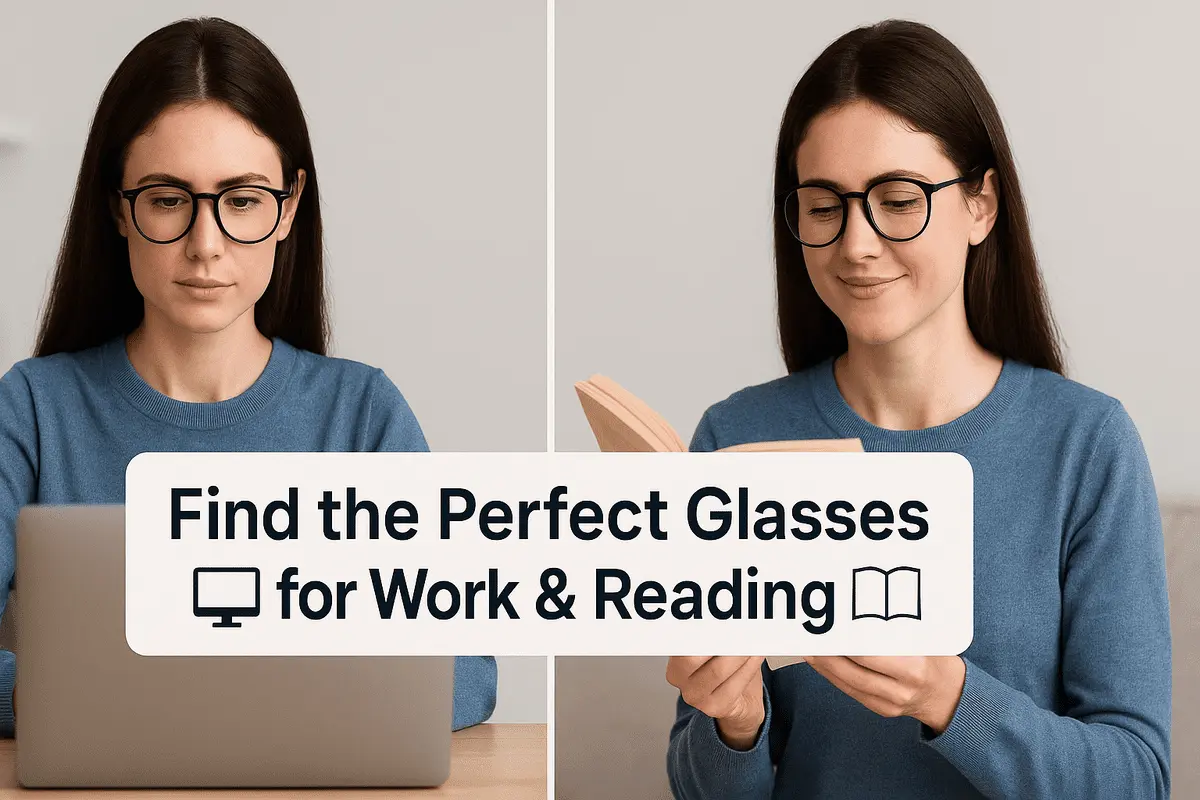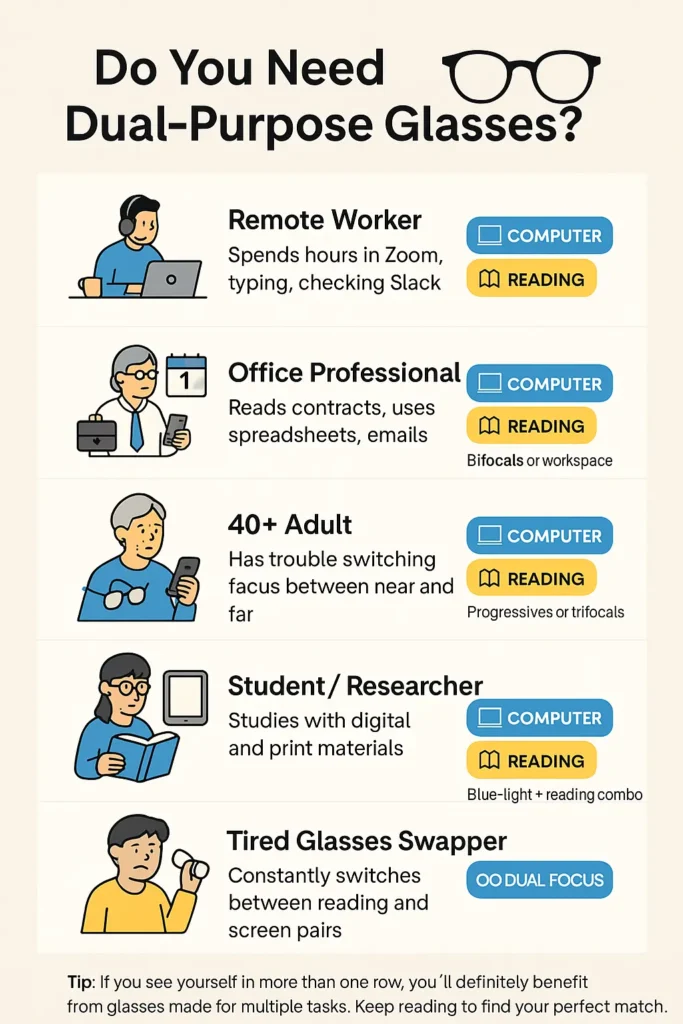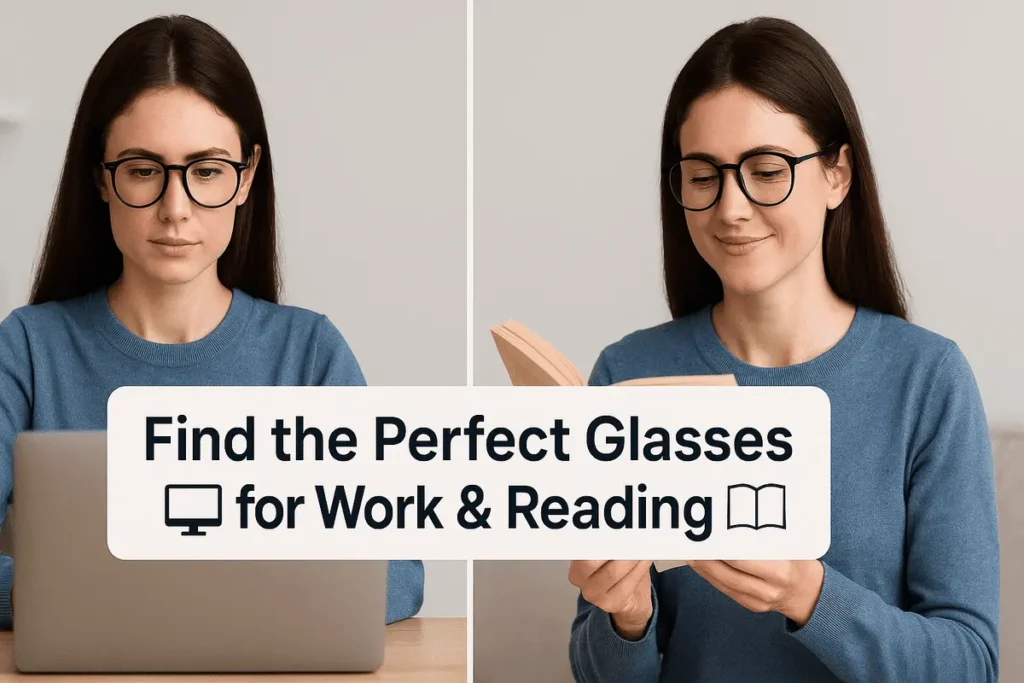👓 Introduction: The Struggle to Find the Right Glasses Is Real
If you’re constantly switching between reading glasses and computer glasses, you’re not alone. Many people struggle to find a single pair that works for both screen time and close-up reading.
Maybe your eyes feel tired after a long Zoom call. Or you notice blurry text when reading on your phone. The truth is, most glasses are designed for one specific task—not multitasking.
But the good news? You don’t have to settle for discomfort or keep swapping glasses all day. There are lens options made for modern life—ones that work well for both digital work and reading books, emails, or websites.
In this guide, we’ll break down:
- The different types of glasses that suit both needs
- How to choose the right lenses based on your lifestyle
- Where to buy them online—with tools to help you get the perfect fit
Let’s simplify your search so you can see clearly—no matter what’s in front of you.
👀 Who Needs Glasses for Both Computer Work and Reading?
You might think glasses are one-size-fits-all—but they’re not, especially when your day includes both screen time and close-up reading. The right pair depends on how you use your eyes throughout the day.
Here are some common situations where dual-purpose glasses make a big difference:
- Remote workers and freelancers
Jumping between emails, spreadsheets, and printed notes requires clear vision at multiple distances. - Professionals in hybrid jobs
Whether you’re coding, writing reports, or reading contracts, multitasking demands flexible lenses. - People over 40
As we age, our eyes naturally lose the ability to focus on close objects—a condition called presbyopia. If you’re noticing text blur or headaches, you may need more than just readers. - Students and lifelong learners
Switching between textbooks, online articles, and Zoom lectures? A single pair of the right glasses can keep you focused longer. - Anyone tired of swapping glasses all day
If you keep a pair of readers on your desk and another set for screens, it’s time for an upgrade.
If you fit into any of these categories, the next sections will help you understand what kind of lenses solve your specific needs—and how to buy them confidently online.
🔍 Understanding Your Vision Needs
Before you choose the right glasses, it’s important to understand how your eyes work at different distances. Not all lenses are created equal—and picking the wrong type can leave you with blurry vision, eye strain, or constant frustration.
👁️ The Three Vision Zones You Use Every Day:
- Distance Vision—For things far away, like driving or watching TV
- Intermediate Vision—About 20–26 inches from your eyes, ideal for computer screens
- Near Vision—14–16 inches from your eyes, perfect for reading books or your phone
Most people need help with more than one zone—especially if they spend a lot of time multitasking or are over 40.
🧠 Why This Matters:
- Reading glasses only help with near vision
- Computer glasses are designed for intermediate vision
- If you switch between both tasks, you’ll need a lens that can handle multiple zones
📏 Quick Tip: Measure Your Screen Distance
Grab a measuring tape and check how far your eyes are from your screen when seated comfortably. If it’s more than 20 inches, reading glasses alone won’t cut it.
Understanding these zones will help you match your daily tasks to the right type of lens—so you can stop squinting and start seeing clearly.
🕶️ Types of Glasses That Work for Both Reading and Screen Use
Choosing the right glasses means picking lenses that match how you use your eyes. Here’s a quick guide to the main types that can handle both reading and computer work:
| Glasses Type | Best For | Pros | Cons |
|---|---|---|---|
| Reading Glasses | Close-up tasks (books, phones) | Inexpensive and easy to buy | Not suitable for computer distance; can cause eye strain |
| Computer Glasses | Screen use at arm’s length | Designed for intermediate range; reduce glare and sometimes blue light | Not good for very close reading |
| Progressive Lenses | Seamless use for all distances | No visible lines; covers near, intermediate, and distance vision | More expensive; may take time to adjust |
| Bifocal/Trifocal | Separate zones for reading and distance | Clear lens division for each distance | Visible lines can look outdated and less stylish |
| Task-Specific Glasses | Customized for specific activities | Tailored to your work and vision needs | Requires professional fitting; can be costly |
Quick Overview
- Reading Glasses: Great for near work but awkward at your computer.
- Computer Glasses: Perfect for screens but not for reading books.
- Progressives: The all-in-one solution for those who need multiple distances covered.
- Bifocals/Trifocals: Good if you want distinct zones, but they aren’t as popular today.
- Task-Specific: Best for complex needs or specific professions.
This chart can help you visualize which glasses fit your lifestyle and vision needs.
🧠 How to Choose the Right Glasses for You (Decision Matrix)
Finding the perfect pair means matching your vision needs with your daily habits. Use this simple step-by-step process to decide which glasses suit you best:
Step 1: Get an Up-to-Date Eye Prescription
Even if you own glasses already, vision changes over time. Visit your optometrist to ensure your prescription is current and accurate.
Step 2: Define Your Primary Use
- Mostly computer work? You’ll need lenses optimized for intermediate distances (computer glasses or progressives).
- Mostly reading? Reading glasses may be enough.
- Both equally? Consider progressives or bifocals.
Step 3: Measure Your Working Distance
- Measure how far your eyes are from your screen or reading material.
- If your screen distance is between 20 and 26 inches, computer glasses or progressives will serve you better.
- For distances under 16 inches, reading glasses work well.
Step 4: Consider Your Lifestyle and Budget
- Do you want a single pair for everything or multiple pairs?
- Are you okay with a higher price for convenience (like progressives)?
- How important are style and frame choice?
Quick Decision Tree
| Use Case | Recommended Glasses |
|---|---|
| Mainly screen use | Computer glasses |
| Mainly reading | Reading glasses |
| Both reading & computer use | Progressive lenses |
| Need sharp separation | Bifocal or trifocal lenses |
| Specialized tasks | Task-specific lenses |
Still Not Sure?
Jump to our recommended online retailers below—many offer virtual try-ons and easy returns to help you find your perfect fit risk-free.
🛒 Where to Buy the Right Glasses Online (With Try-On Tools)
Buying glasses online has never been easier or more convenient. Many retailers offer virtual try-on tools, affordable prices, and hassle-free returns. Here are some of the best places to find glasses that work for both computer use and reading:
1. Zenni Optical
- Why choose them? Affordable custom prescription glasses, including progressives and computer lenses.
- Features: Virtual try-on, wide frame selection, prescription upload.
- Price Range: Starting as low as $30.
2. Warby Parker
- Why choose them? Stylish frames, home try-on kits, and excellent customer service.
- Features: Virtual try-on app, free 5-day home trial, blue-light filtering options.
- Price Range: Mid-tier pricing, around $95-$145.
3. EyeBuyDirect
- Why choose them? Frequent discounts and a large selection of blue-light and progressive lenses.
- Features: Virtual try-on, extensive lens customization, 14-day returns.
- Price Range: Budget-friendly to mid-range.
4. GlassesUSA
- Why choose them? Wide brand selection, including designer frames, often with deep discounts.
- Features: Prescription upload, virtual try-on, fast shipping.
- Price Range: Mid- to high-end.
What to Look for When Buying Online:
- Virtual Try-On: Try frames on using your phone or computer camera.
- Return Policy: Look for easy returns or home trials in case the fit isn’t right.
- Lens Options: Make sure they offer progressive, blue-light blocking, and anti-reflective coatings.
- Prescription Upload: Confirm they accept your current prescription and pupillary distance (PD).
Pro Tip: Order two pairs if you want one for work and one for reading, or try progressives to cover both needs with one pair.
💡 Expert Tips for First-Time Buyers
Choosing glasses for both computer work and reading can feel overwhelming. Here are some expert tips to make the process easier and help you get the best value:
1. Look for Anti-Reflective Coating
This reduces glare from screens and overhead lighting, making your eyes feel less tired during long work sessions.
2. Consider Blue-Light Filtering, But Don’t Expect Miracles
Blue-light lenses may reduce digital eye strain for some, but research shows they aren’t a cure-all. Prioritize proper lens power and fit first.
3. Choose Lightweight Frames for Comfort
You’ll be wearing these glasses for hours. Frames made from materials like acetate or titanium feel lighter and reduce pressure on your nose and ears.
4. Don’t Rely on Over-The-Counter Readers for Screen Use
OTC readers are designed for close reading, not intermediate distances like computer screens. Using them at the wrong distance can cause eye strain.
5. Verify Your Pupillary Distance (PD)
Accurate PD measurement ensures your lenses align properly with your eyes for the clearest vision.
6. Give Progressive Lenses Time to Adjust
If you’re trying progressives for the first time, it might take a week or two to get used to the different lens zones.
“Getting the right fit and lens type can make a huge difference in eye comfort and productivity,” says Dr. Lisa Chen, an optometrist with 15 years of experience.
⚠️ Common Mistakes to Avoid
When shopping for glasses that work for both computer use and reading, avoid these common pitfalls:
1. Using Reading Glasses for Computer Work
Reading glasses are made for close-up vision and can cause eye strain or headaches if used for longer distances like screens.
2. Choosing the Wrong Prescription
Don’t guess your prescription or use an old one. Even small changes in vision can impact comfort and clarity.
3. Ignoring Return Policies
Buying online can be tricky. Always check the return or exchange policy before purchasing, so you’re not stuck with glasses that don’t fit or don’t work for your needs.
4. Skipping Lens Coatings
Anti-reflective and scratch-resistant coatings help prolong your glasses’ life and reduce glare, improving your comfort and vision.
5. Expecting Blue-Light Glasses to Fix All Eye Strain
While blue-light glasses can help reduce glare, they don’t solve all digital eye strain issues. Proper lens strength and good lighting matter more.
6. Buying Frames Based Only on Style
Comfort and fit are just as important as looks. Frames that pinch or slide will distract you and can cause headaches.
Pro Tip: Always order from reputable sellers that offer virtual try-ons or home trials to minimize risks.
❓ Frequently Asked Questions (FAQ)
Can I use reading glasses for computer work?
Reading glasses are designed for close distances. Using them for computer screens (which are farther away) can cause eye strain.
What are progressive lenses?
Progressives offer a smooth transition between distance, intermediate, and near vision zones—eliminating the need to switch glasses.
Do blue light glasses really help?
Blue-light lenses may reduce glare and improve comfort for some users, but they aren’t proven to prevent eye damage or completely eliminate digital eye strain.
Can I buy prescription glasses online?
Yes! Many reputable online retailers accept prescriptions and offer virtual try-on tools and home trials.
How do I know my pupillary distance (PD)?
Your optometrist can provide your PD during an eye exam, or you can measure it at home using online guides or apps.
📋 Summary: Choose Smarter, See Sharper
Finding the right glasses for both computer work and reading doesn’t have to be confusing. Remember these key points:
- Understand your vision zones: Near, intermediate, and distance.
- Pick the right lens type: Computer glasses for screen use, reading glasses for close work, or progressives for all-in-one convenience.
- Get an up-to-date prescription: Your eyes change, and so should your glasses.
- Buy from trusted online retailers: Use virtual try-ons and check return policies.
- Avoid common mistakes: Don’t rely on OTC readers for screens, and prioritize comfort with proper coatings.
Your 3-Step Action Plan:
- Schedule an eye exam to update your prescription.
- Measure your typical screen and reading distances.
- Use our recommended online shops to find glasses that match your needs and style.
Ready to Find Your Perfect Pair of Glasses?
Don’t settle for eye strain or juggling multiple pairs. Whether you need glasses for computer work, reading, or both, the right lenses are just a few clicks away.
Take the next step:
- Get your eyes checked by a professional.
- Measure your screen and reading distances.
- Explore trusted online retailers like Zenni, Warby Parker, and EyeBuyDirect.
Start shopping smart today and enjoy clearer, more comfortable vision—no matter what you’re looking at.


